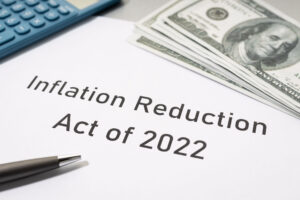 For proponents of the §179D deduction for energy-efficient commercial buildings, the past two years have yielded some major victories. After being made a permanent part of the tax code in December 2020, the deduction has now been significantly expanded by the Inflation Reduction Act of 2022. Signed into law by President Biden on August 16, the new law raises the maximum deduction amount from $1.88 to $5 per square foot, lowers the threshold for qualifying energy efficiency measures, and allows new categories of building owners to allocate their deductions to primary designers.
For proponents of the §179D deduction for energy-efficient commercial buildings, the past two years have yielded some major victories. After being made a permanent part of the tax code in December 2020, the deduction has now been significantly expanded by the Inflation Reduction Act of 2022. Signed into law by President Biden on August 16, the new law raises the maximum deduction amount from $1.88 to $5 per square foot, lowers the threshold for qualifying energy efficiency measures, and allows new categories of building owners to allocate their deductions to primary designers.
How much is the §179D deduction now worth?
Buildings that are placed into service after December 31, 2022 and meet the eligibility requirements for §179D may qualify for a deduction of up to $5 per square foot. However, the specific deduction amount is based on a sliding scale:
- Projects that achieve a minimum of 25% energy cost savings compared to the applicable ASHRAE Standard (a notable decrease from the previous requirement of 50% cost savings), but do NOT comply with local prevailing wage and apprenticeship requirements for workers associated with the project, will qualify for a deduction of at least $0.50 per square foot. Each 1% of additional savings above 25%, up to 50%, will yield an additional deduction of $0.02, up to $1 per square foot. The wage requirement is a new addition to §179D.
- Projects that achieve a minimum of 25% energy cost savings and do meet the local prevailing wage and apprenticeship requirements will be eligible for a minimum deduction of $2.50 per square foot; each 1% of additional savings will yield a $0.10 per square foot deduction, up to the maximum amount of $5.
Who can claim the §179D deduction?
Most frequently, the §179D deduction is claimed by commercial building owners who install qualifying energy efficiency measures. The Inflation Reduction Act has now extended the deduction to real estate investment trusts (REITs) as well.
In addition, the primary designers—such as architects, engineers, contractors, and green building consultants—of qualifying energy efficiency measures in certain buildings may be eligible for the deduction. Prior to 2023, these buildings only include those owned by local, state, and federal government entities. However, the new law adds nonprofit organizations, tribal entities, religious institutions, and not-for-profit schools and universities to the list of entities that may allocate their §179D deductions to primary designers.
ASHRAE Standards for §179D deduction
As mentioned above, qualifying projects must reduce energy costs by at least 25% compared to the applicable standard from the American Society of Heating, Refrigerating and Air-Conditioning Engineers (ASHRAE). Prior to the Inflation Reduction Act, this was whichever standard was in effect two years before construction began (ASHRAE 90.1-2019 for projects completed in 2021). The new law changes this to the ASHRAE Standard in effect four years before completion of construction. Projects must be certified by a third-party using Department of Energy-approved software to confirm that they meet these requirements.
§179D deduction reset
Another notable change under the Inflation Reduction Act is that it allows commercial buildings to be re-certified for the §179D deduction every three years, and every four years for buildings owned by the government and other not-for-profit entities. Previously, the deduction could only be claimed once over the lifetime of a building.
§179D examples
Given the typically large square footage of commercial buildings, the §179D deduction often yields five-, six- or even seven-figure tax savings. For example, with the growth of e-commerce, many new distribution centers have been built in the U.S. This is an excellent category for §179D deductions: under the Inflation Reduction Act, a 1 million-square-foot distribution center could qualify for a $5 million tax deduction.
With these exciting changes to the §179D deduction taking effect starting in 2023, commercial building owners and primary designers will soon have significantly greater opportunities to minimize their tax burdens based on qualifying energy efficiency projects. However, the Inflation Reduction Act also increases funding for the IRS by $80 billion over the next 10 years, with a main goal of enforcing tax code compliance—so it will be more important than ever for taxpayers to ensure that they are abiding by all applicable rules and regulations.
In order to ensure tax code compliance while maximizing savings, the key is to work with a qualified §179D certification firm such as Capital Review Group. With a unique combination of tax and engineering expertise, our team has helped numerous clients receive substantial tax savings through this deduction alone. Contact us today to schedule a consultation or learn more about the newest changes to the §179D deduction!